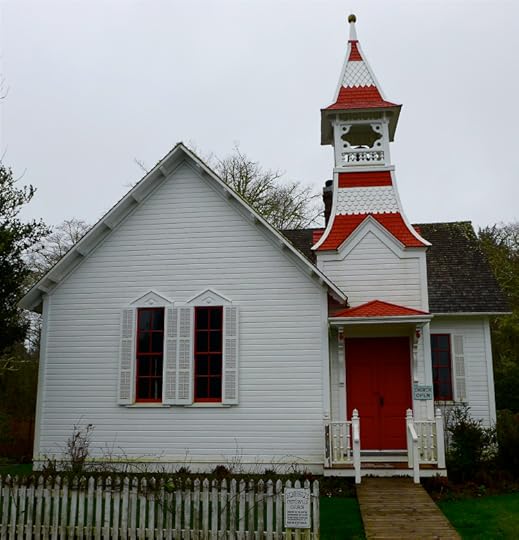Journey: Oysterville
Winter clouds hang low over the wide expanse of bay, giving an even shade of light to the scene. It is not raining, but a squall passed recently and every surface, including the snowberries, glistens wet. Gusts of fresh wind press at the grasses and on the bleached cannery a loose piece of corrugated metal works against its fastenings with each blast. Weathered pilings stick out of the mud like bones. The view is spare; warm earthy tones of dry sedge and pale beach grasses give way to the deep chocolate of bay mud that extends far into the distance. This is Oysterville’s view of its estuary, the fertile bay that gave the town its life and has since taken some back.
To turn around and view the town from the bay is to see its face (what are now the fronts of the houses from the road were their original backs). Chimney smoke lies out flat against the blue silhouettes of the forest backdrop. A dozen houses are at least partly visible, enclosed in shrubs and yard trees. A few have picket fences.
Born as a seafood larder for California’s hungry miners in 1854, Oysterville, by rights, should be gone now. Most of the towns founded with it are. Its native oysters vanished long ago, picked clean out. Its saloons and hotels quieted long ago and faded away. Most of its sons and daughters have long since found promise elsewhere. A few of its families remain, along with a handful of its houses, some decorated in gingerbread trim and freshly glazed paint, others weedbound and sagging. In Oysterville, time and the bay show their marks, but the greater part of civilization does not. Its position near the end of the Long Beach Peninsula hasn’t been a stopping point on the way to anywhere since bay steamers stopped transferring passengers many decades ago. Unless you intend specifically to visit Oysterville, chances are you won’t.
Yet for all of its isolation and bygone splendor, Oysterville attracts visitors. It would be entirely fair to say that the town enjoys a renaissance that few other communities of the coast can likewise claim. Not because of some economic development scheme, or fast-buck theme hype. Visitors don’t come to look at illusion, they come instead to squint into time, to see a community that remains in appropriate scale with its past; honest with itself.
On July 4, 1976, Oysterville was dedicated as a National Historic District, an 80-acre site containing 12 houses and two public buildings (a school and a church) built before 1910; 14 or 15 buildings constructed in the 1920s; and three or four “new” houses. “New” means they were built since 1935. The dedication followed nearly four years of effort by Dale Espy Little, granddaughter of one of the town’s founders, Robert H. Espy.
Espys have had a stake in Oysterville since Chief Nahcati showed Robert Espy the wealth of oysters that grew on the unsettled side of Shoalwater Bay in 1854. A town bloomed, many of its buildings constructed out of redwood lumber used to ballast the empty oyster schooners on their trip from San Francisco. When the oysters failed, Espys remained. Those who left returned periodically, drawn by family gatherings and the natural magnetism of scenes unchanged, faithful to memories.
Those memories went public with Willard Espy’s Oysterville: Roads to Grandpa’s Village, published in 1977. The book formed a roadmap through the private history that led to the town’s founding. Some say the bookmade the Espys everybody’s pioneer family. If so, his sister Dale’s efforts to preserve the historical site made Oysterville everybody’s pioneer town. Today, many visitors to Oysterville know the town intimately even before they see it, and when they see it, recognition is complete.
There is some quality in Oysterville that lets it be the sum of over 160 years of history on Washington’s Coast. It retains its human presence in correct proportion to its natural setting. It reveals what allegiance to a place can offer as rewards. It affords an intangible continuity, where past and future blend, where generations visit but leave few marks. Oysterville persists in part because its preservation threatened no grander development; ambition had moved on. What it left was the elegance of an earlier time preserved to shape its future.
The historic Baptist Church in Oysterville was built in1892. It is owned now by the Oysterville Restoration Foundation.
Photographs and text: Copyright © 1987 & 2015 Robert Steelquist. All Rights Reserved







